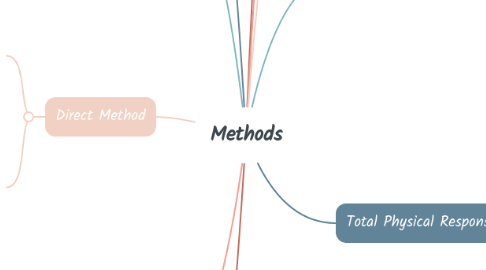
1. Communicative Method
1.1. Communication in authentic situations, focus on fluency and the functional use of language. Grammar is taught in context.
1.1.1. Example (role-playing activities, such as ordering food in a restaurant or asking for directions, allowing students to use language in real-life contexts)
1.2. Advantages: - Encourages fluency and real-world language use. - Engages students in meaningful interaction.
1.2.1. Disadvantages: - Accuracy and grammatical precision may be neglected. - Progress in language form can be harder to track.
2. Audio-Lingual Method
2.1. Repetitive drills and the formation of language habits through imitation and memorization, often based on behaviorist psychology
2.1.1. Example (the teacher models a sentence, and students repeat it several times: "I am a teacher. You are a teacher. She is teacher.")
2.2. Advantages: - Good for developing pronunciation and listening skills. - Immediate feedback helps reinforce correct responses
2.2.1. Disadvantages: - Focuses too much on memorization, neglecting understanding. - Lacks opportunities for creative or authentic language use
3. Direct Method
3.1. Teaching language through direct exposure without translation. Grammar is taught inductively, and the target language is used exclusively.
3.1.1. Example (the teacher points to objects and says their names in English, without translating them into the students' native language. Students respond by repeating the words)
3.2. Advantages: - Emphasizes speaking and listening skills from the start. - Mimics natural language learning processes.
3.2.1. Disadvantages: - Can be difficult for abstract concepts. - Lacks emphasis on reading and writing skills.
4. Audio-Visual Method
4.1. Uses audiovisual materials, such as videos, pictures, and sounds, to teach language in context. Visual cues help students understand language input
4.1.1. Example (a video showing people interacting in a restaurant, followed by students imitating the interactions based on the visual and auditory input they received)
4.2. Advantages: - Provides context and enhances understanding through visual cues. - Appeals to multiple learning styles (visual and auditory).
4.2.1. Disadvantages: - May over-rely on technology. - Limited focus on spontaneous spoken communication.
5. Presentation, Practice, Prodiction
5.1. Structured approach where language is first presented (through a model), practiced (in controlled activities), and finally produced by the students in freer tasks.
5.1.1. Example (lesson on the past tense: the teacher explains the rules (presentation), students complete exercises filling in blanks (practice), and then they create their own sentences or dialogues (production))
5.2. Advantages: - Clear, systematic structure for both teachers and learners. - Builds confidence through guided practice before freer tasks.
5.2.1. Disadvantages: - Can become too teacher-centered and rigid. - May not always promote natural language use in the production phase.
6. Silent Way
6.1. The teacher remains largely silent, prompting learners to discover language patterns on their own. Visual aids, such as colored rods, are often used to represent structures.
6.1.1. Example (the teacher places rods on a table to represent different parts of a sentence, and students manipulate the rods to form correct sentences)
6.2. Advantages: - Promotes learner autonomy and problem-solving. - Engages learners in a discovery process.
6.2.1. Disadvantages: - Can be confusing without sufficient teacher guidance. - Lacks emphasis on communicative practice.
7. Task Based Learing
8. Grammar-Translation Method
8.1. Reading and translating texts from the target language into the students' native language, with strong emphasis on grammar rules.
8.1.1. Example (students translate classical texts or sentences from English to their native language, learning grammar rules by practicing translation)
8.2. Advantages: - Provides a deep understanding of grammatical structures. - Focus on reading and writing skills.
8.2.1. Disadvantages: - Lacks emphasis on speaking and listening. - May result in students knowing grammar but being unable to communicate effectively.
9. Test, Teach, Test
9.1. Cyclical approach where students are first tested on their knowledge, taught the language they struggled with, and then tested again to assess their improvement.
9.1.1. Example (students take a pre-test on verb tenses, the teacher provides targeted instruction based on errors, and students take a post-test to check progress)
9.2. Advantages: - Tailors instruction to the learners’ specific needs. - Clear way to measure progress and target gaps in knowledge.
9.2.1. jj
10. Total Physical Response
10.1. Links language learning to physical movement, with students responding to commands that require physical actions.
10.1.1. Example (the teacher says "Stand up" or "Pick up your pen," and students physically perform the action)
10.2. Advantages: - Effective for beginners and young learners. - Helps internalize language through physical response.
10.2.1. Disadvantages: - Limited to certain types of vocabulary and grammar. - Less effective for advanced learners and abstract concepts.
